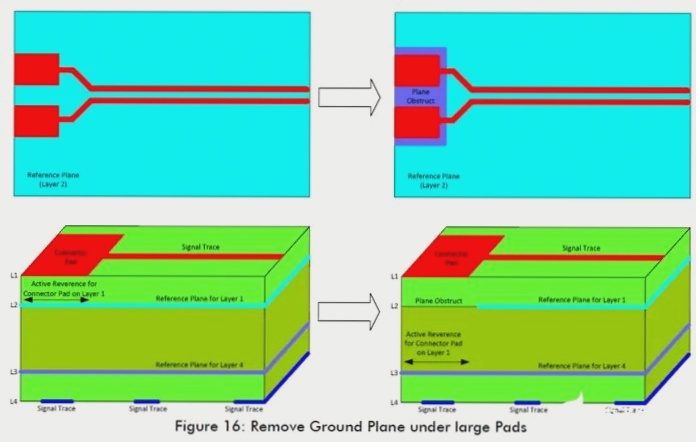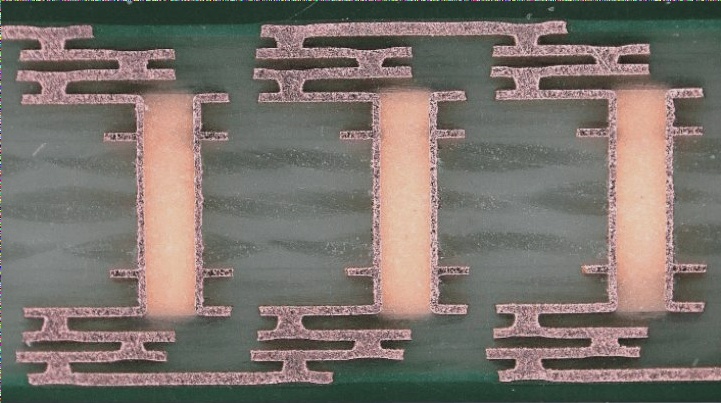In many cases, digital circuits require intermittent current, resulting in surge current for high-speed devices. If power supply circuits are lengthy, inrush current can lead to high-frequency noise, which can be introduced into other signals. Additionally, high-speed circuitry will inherently have parasitic inductance, resistance, and capacitance, causing high-frequency noise to couple to other circuits. This can lead to a drop in the circuit’s ability to withstand surge current, resulting in potential disability for the circuit.
Therefore, it is crucial to add a bypass capacitor in front of the digital device. The capacitance should be large enough to effectively transmit energy within the transmission rate limitations. Typically, a combination of a large capacitor and a small capacitor is used to satisfy the full frequency range.



Avoiding Hot Spot Generation:
When it comes to through-hole placement, it’s important to be mindful of potential hot spot generation. Signal through-holes have the potential to create voids in the power layer and the underlying layer, leading to increased current density in certain areas of the power supply or ground plane. These areas of increased current density are referred to as hot spots. To prevent hot spot generation and potential EMC problems, it’s crucial to carefully consider the placement of through holes. One effective way to avoid hot spots is to use a mesh pattern for through-hole placement, ensuring uniform current density and preventing isolation of the plane, which in turn avoids long backflow paths and potential EMC issues.
Bending Mode of PCB Routing:
When routing high-speed signal lines, it’s important to minimize bending as much as possible. If bending is necessary, sharp or right angles should be avoided in favor of obtuse angles. Snake lines are often used in the layout of high-speed signal lines to achieve consistent length, but it’s essential to consider the bending of the line in this process. Proper choices regarding line width, spacing, and bending mode are critical, and spacing should adhere to the 4W/1.5W rule.

1. The proximity of the signal lines
2. If the distance between high-speed signal lines is too close, it is easy to produce crosstalk. Sometimes, due to layout constraints, frame size, and other factors, the distance between high-speed signal lines exceeds our minimum requirements. In such cases, we have to increase the separation between high-speed signal lines near the bottleneck. In fact, if space allows, it is recommended to increase the distance between the two high-speed signal lines.
1. PCB routing stubs
2. Long stub lines can act as antennas, potentially causing serious EMC problems if not handled properly. Additionally, stub lines can also create signal reflections, compromising signal integrity. Stub lines are commonly created when pull-up or pull-down resistors are added to high-speed signal lines, and it is important to properly manage these stub lines. As a general rule, stub lines longer than 1/10 of a wavelength can pose problems and function as antennas.
1. Impedance discontinuity
2. The impedance value of a trace generally depends on its line width and the distance between the trace and the reference plane. The wider the trace, the lower the impedance. This same principle also applies to interface terminals or device pads. For example, when the pad of an interface terminal is connected to a high-speed signal line, a large pad will have a lower impedance, while a narrow signal line will have a higher impedance, causing impedance discontinuity and leading to signal reflection.
3. To address this issue, a copper sheet can be placed under the large pad of the interface terminal or device, with the reference plane of the pad placed in another layer to increase the impedance and ensure impedance continuity.
4. Perforations are another source of impedance discontinuity. To minimize this effect, unwanted copper sheeting for inner and through connections should be removed. This operation can be performed during the design phase using CAD tools or by contacting PCB manufacturers to eliminate unnecessary copper skin, ensuring impedance continuity.

1. Differential signal
2. For high-speed differential signal lines, it is crucial to ensure equal width and equal spacing in order to achieve specific differential impedance values. Therefore, it is essential to distribute the differential signal lines with as much symmetry as possible.
3. Avoid placing holes or components in the differential lines, as doing so can lead to EMC problems and impedance discontinuity.

1. Sometimes, high-speed differential signal lines may require serial coupling capacitors. These coupling capacitors should be arranged symmetrically, and the package size should not be too large. It is recommended to use 0402 and 0603 capacitors, with 0805 capacitors being acceptable but not preferred. Side-by-side capacitors should be avoided if possible.
2. In general, through-holes cause impedance discontinuity, so for high-speed differential signal pairs, through-holes should be minimized. If through-holes are necessary, they should be arranged symmetrically.

Isometric problem
1. In some high-speed signal interfaces, such as buses, the arrival time and delay error between signal lines should be considered.
2. For example, in a set of high-speed parallel buses, the arrival time of all data signal lines must be guaranteed within a certain time delay error to ensure its establishment time and maintain time consistency.
3. In order to satisfy this requirement, we have to consider equivalence.
4. However, the high-speed differential signal line must guarantee strict time delay for the two signal lines, otherwise, communication failure is likely.
5. Therefore, in order to meet this requirement, the serpentine line can be used to achieve equal length, and then the time delay requirements can be satisfied.
6. Serpentine lines should generally be placed at the source of the loss rather than at the distal end.
7. It is at the source that the signals from the positive and negative ends of the different line are transmitted synchronously most of the time.

1. Wiring bending contributes to the loss of length in PCBs.
2. When a wire is bent, the length between the bends should be kept close to the bend (<=15mm) in order to achieve equal length.
3. If two wires are bent and the distance between them is <=15mm, the loss of length between them will compensate each other, thus equal length processing is not necessary.

For different parts of high-speed differential signal lines, they should be independent and equal in length. The through-hole, series-coupling capacitance, and interface terminal are two parts of the high-speed differential signal line, so special attention should be paid to this. Make sure they are equally long. Because a lot of EDA software in DRC is only concerned about whether the whole line is lost.
For interfaces such as LVDS display devices, there will be a number of pair difference pairs at the same time, and the timing sequence requirements between the different pairs are usually very strict, and the time delay requirements are very small. Therefore, for such differential signals, we generally require compensation in the same plane. Because the signal speeds are different at different layers.

1. As a PCB expert, it is important to note that some EDA software calculates the wiring inside the pad within the length when determining wiring length. In such cases, conducting length compensation at this stage can lead to loss of accuracy in the final result. Therefore, special attention must be paid when utilizing certain EDA software.
2. Whenever possible, opt for symmetrical outings to prevent the necessity of resorting to serpentine routing for equal length.

1. If space permits, try adding a small loop at the source of the short differential line to achieve compensation, instead of using a serpentine line for compensation.
1. PCB, or printed circuit board, is an essential component of modern electronics.
2. It provides a stable and reliable base for electronic components, allowing them to connect and communicate effectively.
3. PCBs are made from a non-conductive material such as fiberglass, with thin layers of copper foil printed onto them.
4. These copper layers are etched to create pathways for electrical signals to flow between components.
5. The process of creating a PCB involves several steps, including designing the layout, printing the circuit onto the board, and etching the copper layers.
6. Once the PCB is complete, electronic components are soldered onto it to create a functional circuit.
7. PCBs come in various types, including single-sided, double-sided, and multi-layered boards, each suited for different applications.
8. The advancements in PCB technology have allowed for smaller, more efficient circuits to be produced, enabling the creation of smaller and more powerful electronic devices.
9. As a PCB expert, it is crucial to stay updated on the latest developments in PCB technology and manufacturing processes to ensure the production of high-quality PCBs.




